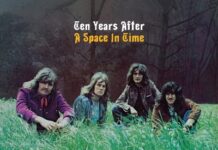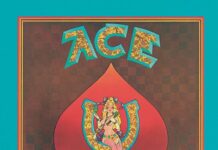So there they were: Lee Jackson and Brian Davison, the rhythm section for
the Nice, left for dead on the side of the road without so much as two shillings
to rub together. All because Keith Emerson needed to move on. Phewy! Well, not
exactly. It kind of worked out for all involved parties, to a certain extent.
Emerson did in fact move on by joining up with Greg Lake and Carl Palmer, a
superior rhythm section to the eyes and ears of many. Together, they basked
in international acclaim for almost 10 years as Emerson, Lake and Palmer. And
after a few years in the shadows, Jackson and Davison found Patrick Moraz, a
Swiss keyboardist with a few tricks up his sleeve, and formed Refugee in 1973.
Even though the group made only one album and barely toured, they did play a
few gigs. A tape found at Davison’s house proves that their potential
as a live act, laying in waiting and ready to tap. Dusted off and cleaned up,
that tape, dubbed Live In Concert – Newcastle City Hall 1974,
is now on CD and available for public consumption.
Refugee shows they mean business form the get-go with the opening instrumental
“Outro – Ritt Mickley.” Stretched across a Nice/ELP palette,
the playing and interaction is top-notch, brisk and confident. “One Left
Handed Peter Pan” provides an excellent platform for a developing chemistry
amongst the three. The weakest element, which was also evident in the Nice,
is the quirky whine of Lee Jackson’s voice — a distrubing cross
between a really hoarse Phil Collins, Popeye the Sailor Man, and Groundskeeper
Willie from The Simpsons. If you don’t let it detract from the
musicianship, which it can do with devastating accuracy, you can appreciate
the context from which it comes. With the exception of ELP, Yes and Genesis,
vocals often fell aside as a negligible afterthought for many progressive rock
bands. Still, as the singer of the Nice’s vast and eclectic repertoire,
he ably adds his bits to Refugee’s rendition of “The Diamond Hard
Blues Apples Of The Moon” and Dylan’s “She Belongs To Me”
with the proper nip and tuck. Jackson and Davison both rise to the challenge
and are clearly at their best. But as the performance progresses, the focus
shifts and falls squarely on Moraz.
At this point in time, Moraz was the new kid in the European rock keyboard
kingdom presided over by the likes of Emerson, Rick Wakeman, Jon Lord and Tony
Banks. His master strokes on “Papillon” place him in the pantheon
of the greats. At the same time, Moraz piles on scads of amorphous layers that
both frighten and entice. He squeezes the Moog for a lot more juice and uses
the Hammond to underscore his command of the harmonious flow of the music. “Grand
Canyon Suite” exhibits a penchant for arching themes and composition in
its grandest from — totally acceptable in those days. Jumping back from
organ top synthesizer to piano, Moraz’s skills were on track enough to
attract the attention of Yes, who offered the keyboardist a job when Rick Wakeman
quit for the first of many times. Reading about Moraz and his acceptance of
Yes’ offer in the paper was like déjà vu for Jackson and
Davison. Declared DOA, Refugee was no more and the Nice rhythm section quietly
shuttled into the darkness of obscurity. A 2002 Nice reunion with Emerson leads
to speculation of a Refugee reunion. What the hell — it seems to be working
for everyone else.
~ Shawn Perry




















